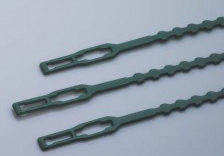
What are the Common Specifications of Cable Ties?
Cable Tie is a type of fastener that’s used to hold various items together. A cable tie is also known as a zip tie or host tie. It’s popular for use in different industries thanks to its ease of use, affordability, and high binding strength.
In most cases, manufacturers tend to use material specifications. ACRHT normally offers a broad range of cables designed for use in different types of environments. This can be on the basis of chemical corrosion, UV light, and flammability among others.
General Purpose Cable Ties
For general purpose cable ties, we design products that can withstand a continuous temperature from -40 up to 185 degrees Fahrenheit.
Outdoor Cable Ties
Cable ties for outdoor applications are usually UV stabilized. This is because they continuously stay outdoors and will, therefore, be exposed to outdoor sunlight. This grade of wires is usually produced by including stabilizers in the nylon resin. It’s worth noting that most of these cables are usually black in color.
We also have heat stabilized cable ties that can withstand temperatures of up to 250 degrees Fahrenheit. These wires also gave heat stabilizers that help to provide them with the much-needed extra thermal endurance.
Whether resistant cables are designed for long-term use, especially in the outdoor environment. Most of them are usually rated effective for use between 12-15 years. This makes them the most ideal solution for use with applications such as solar.
Chemical-Resistant Cable Ties
We also have chemical-resistant cable ties that are mostly used in industries. They are mostly made with distinct materials including:
* Peek: such cables are designed to withstand harsh environments that involve chemicals with high levels of radiation or temperatures. They have non-conductive material with a V-0 flammability rating. This material can withstand temperatures of about 500 degrees Fahrenheit.* Tefzel: it’s a general-purpose type of material that’s resistant to a broad range of chemicals including concentrated sulfuric acid and hydrofluoric acid. Besides that, Tefzel can withstand high levels of moisture since it has a low ability to absorb water content. It meets the 333 IEEE requirements and can withstand radiation up to 100 megarads.
* Polypropylene: it’s the most common type of material used to make cable ties for chemical-resistant applications. Generally, polypropylene is applicable in environments where the effects of chemicals on nylon are a major concern. This material isn’t easily affected by neutral salts, polyhydric alcohols, basic salts, and inorganic acids. Even though it has a good level of chemical resistance, polypropylene has a low tensile strength but it can still withstand UV light exposure.
Stainless Steel Specifications
These are durable cable ties and ideal for long-lasting use. Stainless steel specifications include:
* Type 304 stainless steel: it’s an all-purpose type of austenitic and low carbon stainless steel. It’s designed with a good level of corrosion resistance. Additionally, Type 304 has good weldability. It’s the most used type of stainless steel and can be used to make cable ties for food and chemical processing equipment.* Type 316 stainless steel: it also contains the austenitic chromium-nickel type of steel that’s highly resistant to heat. In addition to that, it has a great level of corrosion resistance and that’s why it’s commonly used to make cable ties for marine use. Type 316 can withstand various types of acids, chemicals, high temperatures, and salts.
Flame-Retardant Applications
These cable ties are designed to withstand high temperatures. They normally include the likes of:
* Halar: it has similar characteristics to Tefzel in terms of performance. Halar can have a lower smoke density, especially when it’s burned. This makes it ideal for high-temperature areas with smoke generation.* HTH 888: it’s a fastening type of material that features a combination of nylon and polyethylene. You can use such types of cables without adhesives.
* HTH 889: it’s another flame retardant version that’s ideal for carrying out air-handling operations.
Color Specifications
This is the simplest type of specification. Overall, cables are usually available in bright and bold colors. You can find them in:
* Black* White
* Purple
* Red
* Green
* Yellow
* Brown
* Orange
* Blue
* Natural-colored ties, etc.
Which Industries Use Cable Ties?
What are the Components of a Cable Tie?
How do You Maintain Cable Ties?
How Do You Determine the Effectiveness of Cable Ties?
How Can You Use Cable Ties at Home?
What are the Quality Standards for Cable Ties?
Are There Other Tools that You Need to Install Cable Ties?
What are the Advantages of Cable Ties?
Basic features of the standard cable ties
How Do You Choose the Right Type of Cable Ties?
What Are the Available Types of Cable Ties?
What is the most common cable tie?
What are the strongest cable ties?

